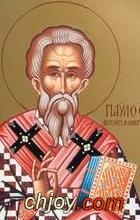
 |
 |
 |
 |
|
رقم المشاركة : ( 1 )
|
|||||||||||
|
|||||||||||
 القديس بولس رئيس أساقفة القسطنطينية /6 تشرين الثاني وُلِدَ بولس في مدينة تسالونيكي وترَّبى تربية صالحة، وجاء إلى القسطنطينية ودخل في سلك الإكليروس، فرقَّاه الكسندرس أسقف القسطنطينية إلى درجة الكهنوت، بعد أن ترقَّى في العلوم والفضيلة. ولمَّا توفي هذا الأسقف سنة 336، انتُخب بولس خلفًا له، على رغم مقاومة الأريوسيين. فقام يدافع عن الإيمان المسيحي بغيرة رسوليّة لا تعرف الملل. فأخذ الأريوسيون خصومه يسعون بجميع الوسائل والتُهم الكاذبة حتى تمكنوا من إبعاده عن كرسيه مرارًا عديدة. فكان يتحمَّل كل ذلك بصدرٍ واسع وصبرٍ جميل. وكان مكدونيوس البطريرك الدخيل يعيث فسادًا في الشعب، ويزيد على البدعة الأريوسية بدعته ضد ألوهيّة الروح القدس. فما سمع البطريرك بولس بذلك، حتى هبَّ من منفاه، غير حافل بغضب الملك قسطنديوس الأريوسي . وجاء يدافع عن أبنائه ويوقيهم شرَّ الضّلال. فأمر الملك بأن يُمسكوه سرًّا بالحيلة، خوفًا من هياج الشعب، فقيَّدوه بالسلاسل وأرجعوه إلى منفاه. فرفع استغاثته إلى البابا القديس يوليوس الأول، فاهتمَّ لأمره وعقد مجمعًا سنة 347، حرم فيه مكدونيوس والأساقفة الأريوسيين. فرجع البطريرك بولس إلى رعيته التي استقبلته بأبهى البهجة والإكرام. وعاد يدافع عن الايمان المسيحي الصحيح. فقام الأريوسيون، كعادتهم، يهاجمونه بوشاياتهم ودسائسهم، حتى نُفي لآخر مرةٍ إلى جبال أرمينيا الصغرى، حيث كان صابرًا على الجوع والحرّ والبرد، مستسلمًا لإرادة الله وأحكامه الغامضة، عاكفًا على الصلاة، إلى أن رقد بالرّبّ سنة 351. صلاته معنا. آمين. Saint Paul the Confessor, Archbishop of Constantinople Saint Paul the Confessor, Archbishop of Constantinople, was chosen to the patriarchal throne after the death of Patriarch Alexander (+ 340), when the Arian heresy had again flared up . Many of the Arians were present at the Council which selected the new Archbishop of Constantinople. They revolted in opposition to the choice of Saint Paul, but the Orthodox at the Council were in the majority. The emperor Constantius, ruling over the Eastern half of the Roman Empire, was an Arian. He was not in Constantinople for the election of the Archbishop, and so it took place without his consent. Upon his return, he convened a council which illegally deposed Saint Paul, and the emperor banished him from the capital. In place of the saint they elevated Eusebius of Nicomedia, an impious heretic. Archbishop Paul withdrew to Rome, where other Orthodox bishops were also banished by Eusebius. Eusebius did not rule the Church of Constantinople for long. When he died, Saint Paul returned to Constantinople, and was greeted by his flock with love. But Constantius exiled the saint a second time, and so he returned to Rome. The Western emperor Constans wrote a harsh letter to his Eastern co-ruler, which he sent to Constantinople along with the holy exiled archpastor. The threats worked, and Saint Paul was reinstated upon the archepiscopal throne. But soon the pious emperor Constans, a defender of the Orthodox, was treacherously murdered during a palace coup. They again banished Saint Paul from Constantinople and this time sent him off in exile to Armenia, to the city of Cucusus, where he endured a martyr’s death. When the Archbishop was celebrating the Divine Liturgy, Arians rushed upon him by force and strangled him with his own omophorion. This occurred in the year 350. In 381, the holy Emperor Theodosius the Great solemnly transferred the relics of Saint Paul the Confessor from Cucusus to Constantinople. In 1326, the relics of Saint Paul were transferred to Venice. Saint Athanasius the Great, a contemporary of Saint Paul, writes briefly about his exiles, “Saint Paul the first time was sent by Constantine to Pontus, the second time he was fettered with chains by Constantius, and then he was locked up in Mesopotamian Syngara and from there moved to Emesus, and the fourth time to Cappadocian Cucusus in the Taurian wilderness.” |
 |
|